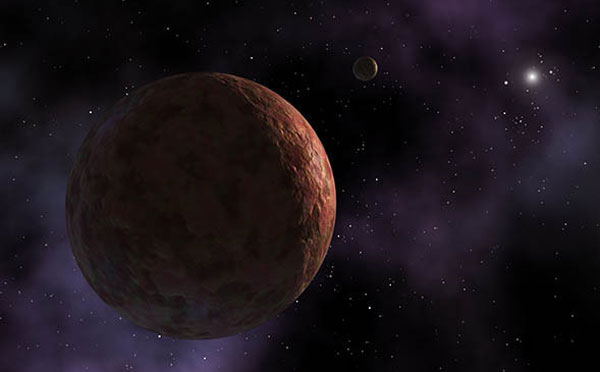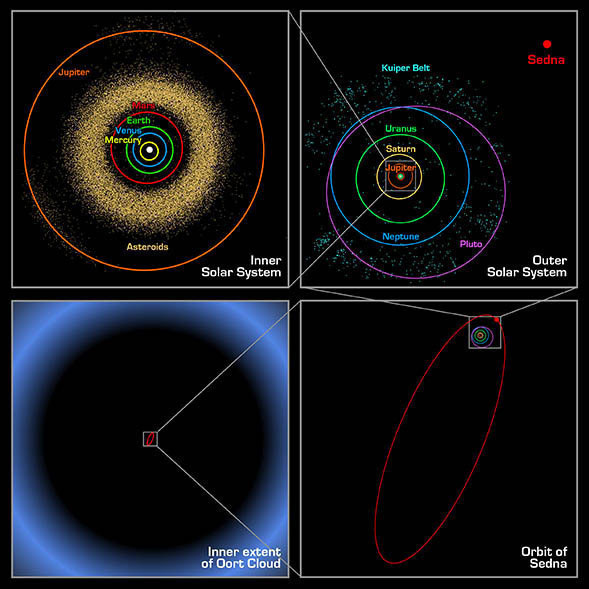New research shows that interactions between small objects beyond Neptune’s orbit —and not a hypothetical Planet Nine — could be the reason some far-flung solar system objects “detach” from their original orbits.
Astronomers have been struggling to explain the orbits of 30 or so bodies at the outer rims of the solar system, called “detached objects.” These worlds are smaller than Pluto and travel in elliptical trajectories around the Sun.

NASA / JPL-Caltech
Sedna is one of the most well-known detached objects: a reddish world found in 2003, it’s one-third the size of the Moon and has an orbital period of 11,400 years — the longest of any object known in the solar system. At closest approach it passes 76 times farther away than the distance between the Sun and Earth. At its farthest, it goes more than 900 times that distance.
The orbits of Sedna and the other detached objects appear to be completely removed from Neptune’s gravitational pull. Yet their trajectories share similarities that seem to point to a common but unknown source of gravitational influence. For that reason astronomers have pointed to the influence of a yet-to-be-found ninth planet of the solar system, hiding far beyond Pluto’s orbit. Astronomers have proposed the existence of this alleged planet to explain not only the detachment of these objects’ orbits, but also other characteristics, such as their orbits’ tilt relative to the plane where most of the planets of the solar system reside.

NASA / JPL-Caltech
But Planet Nine isn’t the only plausible source of disruption in our system’s outskirts. A group of researchers led by Ann-Marie Madigan and Jacob Fleisig (both at University of Colorado, Boulder) have found that the combined gravitational pull of the many smaller bodies beyond Neptune’s orbit (known as trans-Neptunian objects, or TNOs) could do the trick. Thanks to computer simulations, they have found that the combined gravity of the smaller TNOs could push the larger members of their family — such as Sedna — into detached orbits. The researchers presented their findings on June 6th at the 232nd meeting of the American Astronomical Society.
According to Fleisig, the key to this mechanism is the precession of the TNO orbits. If all the objects were the same size, their orbits would move at the same rate and stay stable. But the team’s simulations showed that the larger bodies’ orbits revolve around the Sun more slowly than their smaller counterparts. The motion is similar to the hands of a clock, where the minute hand catches up with the hour hand. When that happens, the larger body feels the gravity of its smaller counterparts piling up behind it. Their combined pull changes the largest object’s path, pushing it away from the Sun.
“For this mechanism to work you need a significant amount of objects out there,” Fleisig says.
That raises the question: Is there enough mass in the outer solar system to make this happen? To Fleisig and his team, the answer is yes. “If we look at the objects that have been detected so far, there’s just a handful of them,” Fleisig says. “We wouldn’t have found them in the time scales that humans have been looking at the sky if that was all there was out there.”
Hal Levison (Southwest Research Institute) says he likes this idea but will remain cautious until the group publishes their work in a peer-reviewed paper, which is currently in preparation. “This could be a really big deal,” Levison says. Nevertheless, he warns, there might be something in the simulations that is “not likely to happen in nature.”
One of the main proponents of the existence of “Planet Nine,” astronomer Mike Brown (Caltech), agrees that the new work puts forward a way to detach objects’ orbits. But he doesn’t think the work rules out the existence of “Planet Nine.” The detachment of the orbits was more a “side effect” of the existence of the rogue planet than the reason to look for it, he argues. “The mechanism discussed here doesn't actually create any of the main effects of Planet Nine, including lining up the orbits, tilting the orbital planes, and generating a population of high-inclination nearby objects,” Brown says. According to Brown, Planet Nine is still required to cause all of these major effects.
However, findings like this may put a bit more of pressure on the supporters of Planet Nine and those actively looking for it. “It’s become a moving target,” Levison says, “I’m very skeptical.” Then he adds, “but not to the point to say we shouldn’t look for it.”
 3
3









Comments
Ron
June 16, 2018 at 8:33 am
Let me be the first to comment that "Planet Nine" is actually a Clump of dark matter. Good luck finding it.
You must be logged in to post a comment.
Jim-Baughman
June 16, 2018 at 2:52 pm
Here’s an interesting conundrum which makes the theory of “dark matter” intellectually shaky—
1. The Milky Way galaxy exhibits motions that conform with the existence of “dark matter”, and that the distribution of this “dark matter” in the Milky Way is almost uniformly smooth.
2. Therefore, dark matter must be pervasive within the solar system, since it is part of the Milky Way and a new, implausibly contorted theory would be needed to explain why dark matter exists everywhere in the Milky Way except our solar system.
3. And yet there has never been any spacecraft launched, no matter how far away in the solar system its destination, that have achieved their targets with extraordinary precision, that has taken “dark matter” into account. Neither has there ever been any orbital calculation of solar system bodies that needed to rely on “dark matter” for them to be understood and plotted exactly.
You must be logged in to post a comment.
RC Silk
July 5, 2018 at 6:28 pm
I strongly suspect astronomers are so set on finding something unique (planet 9) that they're overlooking the mundane: snow drifts. When a plow clears city streets of snow, they throw tremendous amounts of frozen hydrogen and oxygen (snow) along the sidewalks and gutters. The orbits of Uranus, Neptune, Pluto and Friends have likely achieved the same effect: there is a massive amount of snow-drifts from the plowing effects of the outer planets to account for enough accumulated mass (gravity) to mimic a planet 9 effect.
You must be logged in to post a comment.
You must be logged in to post a comment.